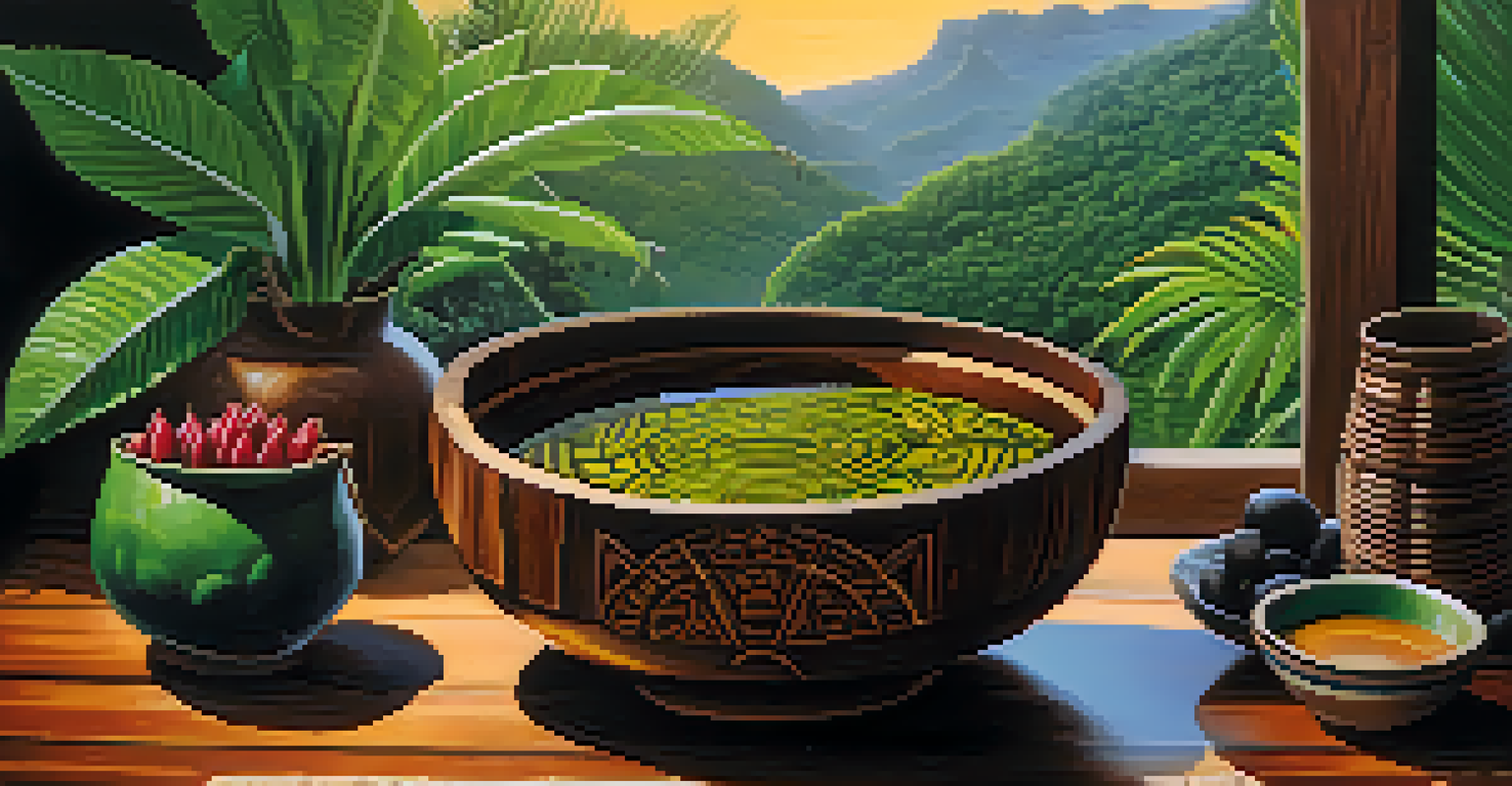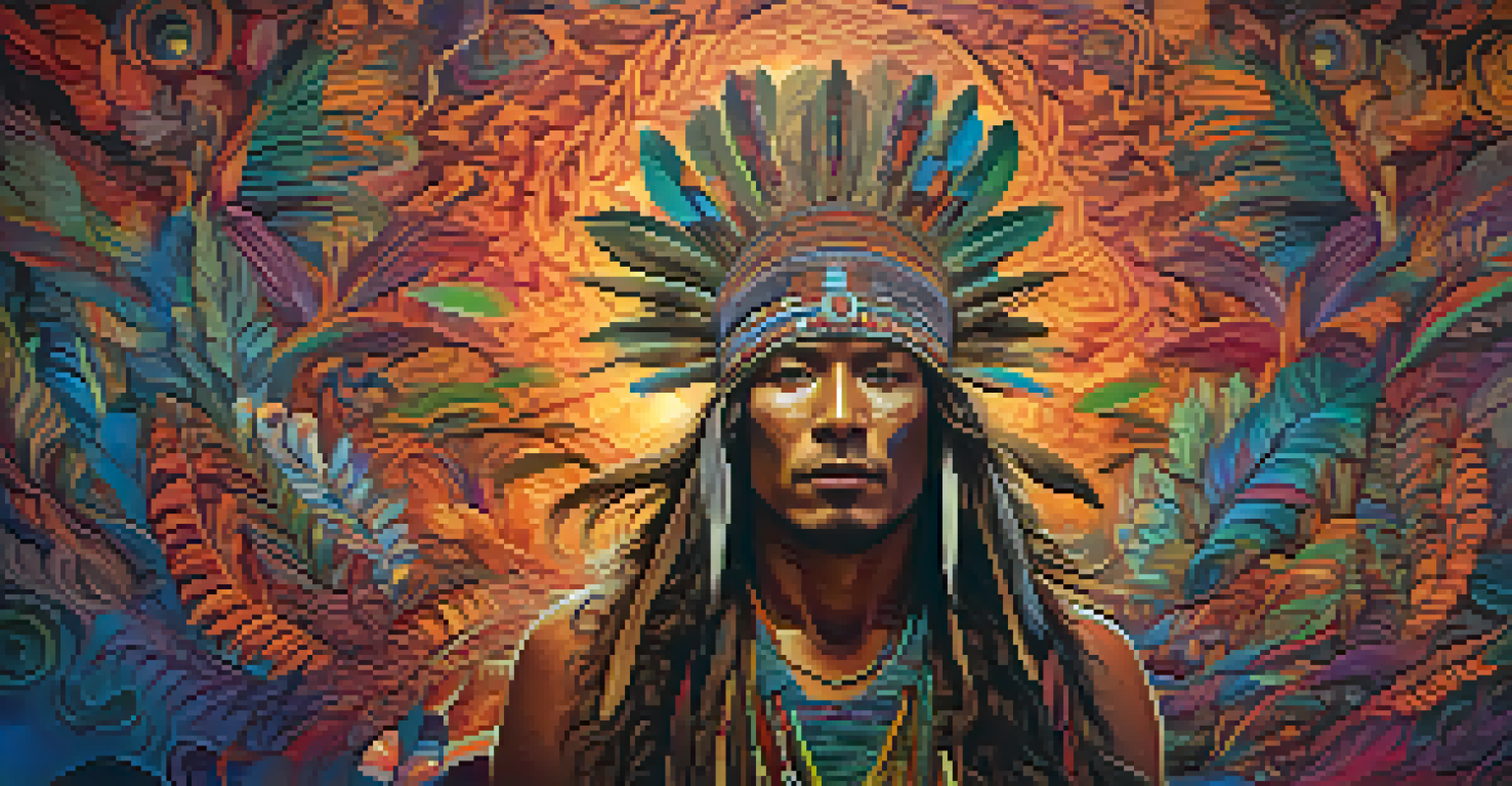Ayahuasca Journeys: Personal Transformations in Indigenous Cultures

Understanding Ayahuasca: A Sacred Plant Medicine
Ayahuasca is a powerful brew made from the Banisteriopsis caapi vine and other plants, traditionally used by indigenous tribes in the Amazon. This sacred medicine is celebrated for its potential to induce profound psychological and spiritual experiences. The ritualistic use of Ayahuasca dates back thousands of years, often intertwined with spiritual beliefs and practices.
Ayahuasca is a teacher, a powerful ally in the healing journey that connects us to our deeper selves and the universe around us.
Participants in Ayahuasca ceremonies often seek healing, insight, or personal transformation. The experience can lead to a deeper understanding of oneself and the universe, sometimes described as a 'journey' into one's psyche. This journey is facilitated by a shaman, who guides participants through the process, ensuring a safe and meaningful experience.
The significance of Ayahuasca extends beyond personal healing; it symbolizes the connection between humans and nature. In many indigenous cultures, the brew is regarded as a teacher, offering lessons and wisdom that can enhance one's life journey.
Cultural Significance of Ayahuasca in Indigenous Communities
In various indigenous cultures, Ayahuasca is not merely a substance but a cultural cornerstone that embodies their worldview. It is often used in communal ceremonies that reinforce social bonds and spiritual beliefs. These gatherings serve as a reminder of the interconnectedness of life, nature, and the cosmos.

The rituals surrounding Ayahuasca use draw on a rich tapestry of mythology and tradition, where the brew is considered a bridge to the spiritual world. Shamans, who hold the knowledge of these practices, play a crucial role in navigating these experiences. Their wisdom ensures that the ceremonies are conducted respectfully and with intent.
Ayahuasca: A Path to Healing
Ayahuasca offers participants a profound journey of self-discovery and healing, often leading to personal transformation and emotional growth.
Through these rituals, indigenous communities maintain their cultural identity and pass down their heritage. The experience of Ayahuasca is often seen as a rite of passage, helping individuals reconnect with their roots and understand their place within the larger community.
Personal Transformation: Healing Through Ayahuasca
Many participants report transformative experiences following their Ayahuasca journeys. The brew can bring unresolved emotions to the surface, allowing individuals to confront and heal past traumas. This process can be deeply cathartic, leading to significant personal growth and a renewed sense of purpose.
The shaman is the bridge between the physical and spiritual realms, guiding us through the mysteries of our own soul.
For some, Ayahuasca serves as a catalyst for change, prompting lifestyle adjustments or shifts in perspectives. The insights gained during these journeys often inspire people to pursue healthier habits or more fulfilling relationships. This transformative power is one reason why Ayahuasca has attracted attention beyond indigenous communities.
However, it's important to approach Ayahuasca with respect and caution. While many have experienced positive outcomes, others may face challenges during their journey. Understanding the emotional and physical implications of the experience is crucial for those considering participating in a ceremony.
The Role of the Shaman in Ayahuasca Ceremonies
The shaman, often viewed as a spiritual guide, plays a vital role in the Ayahuasca ceremony. Their extensive knowledge of the brew and its effects helps participants navigate their journeys safely. Shamans prepare the Ayahuasca, create a sacred space, and lead participants through the experience with traditional songs and rituals.
This guidance is essential, as the Ayahuasca experience can be intense and unpredictable. The shaman's presence offers a sense of security, allowing individuals to explore their inner landscapes with confidence. Many participants report feeling a deep connection to their shaman, who is seen as a bridge between the physical and spiritual realms.
Cultural Roots of Ayahuasca
The practices surrounding Ayahuasca are deeply rooted in indigenous cultures, serving as a vital connection to their traditions and communal identity.
Through their wisdom and experience, shamans help interpret the visions that arise during the journey. They may provide insights or guidance based on the participant's experiences, fostering a deeper understanding of the lessons learned.
Challenges and Misconceptions Surrounding Ayahuasca
Despite its growing popularity, misconceptions about Ayahuasca persist. Many view it solely as a recreational drug, overlooking its deep cultural significance and the care required in its use. This misunderstanding can lead to irresponsible practices that may undermine the traditional ceremonies.
Additionally, while Ayahuasca has been reported to help with various mental health issues, it is not a panacea. Expecting miraculous results can set participants up for disappointment. It's essential to approach the journey with an open mind and realistic expectations, understanding that healing is a process, not an event.
Moreover, the commercialization of Ayahuasca retreats can pose ethical dilemmas, potentially exploiting indigenous practices for profit. Respecting the cultural origins of Ayahuasca and ensuring that ceremonies are conducted ethically is crucial for maintaining its integrity.
Ayahuasca in the Modern World: A Growing Interest
In recent years, Ayahuasca has garnered attention from people outside indigenous communities, leading to a surge in interest. Many seek alternative paths to healing and self-discovery, viewing Ayahuasca as a potential solution. This growing interest has sparked discussions about the ethics and sustainability of Ayahuasca use.
With this influx of participants, there is a pressing need for responsible practices to ensure the safety and well-being of individuals. Educational resources and guidelines can help newcomers understand the cultural context and the importance of respectful engagement with Ayahuasca traditions.
Roles and Responsibilities of Shamans
Shamans play a crucial role in guiding participants through the Ayahuasca experience, ensuring safety and interpreting the spiritual insights gained during the journey.
As more people explore Ayahuasca, the dialogue surrounding its use continues to evolve. This presents an opportunity to bridge cultural gaps and foster a greater appreciation for indigenous wisdom, while also ensuring that the practices remain rooted in respect and authenticity.
The Future of Ayahuasca: Preservation and Respect
As Ayahuasca gains popularity globally, the challenge lies in preserving its cultural roots while accommodating new participants. Ensuring that indigenous voices remain central in discussions about Ayahuasca's future is vital to its sustainability. This can involve supporting indigenous communities in maintaining their practices and protecting their sacred traditions.
Furthermore, fostering respectful dialogue between indigenous cultures and newcomers can promote mutual understanding and respect. By engaging with indigenous leaders and shamans, participants can learn about the significance of Ayahuasca beyond personal use, appreciating its role within a broader cultural context.

Ultimately, the future of Ayahuasca depends on collective efforts to honor its origins. By advocating for ethical practices and promoting education about its cultural significance, we can ensure that Ayahuasca continues to be a source of transformation for generations to come.